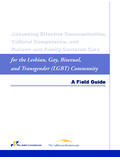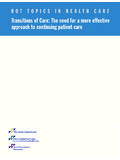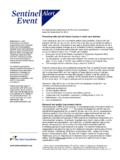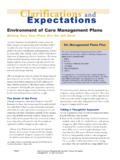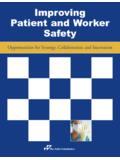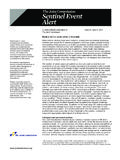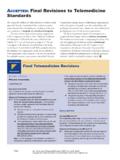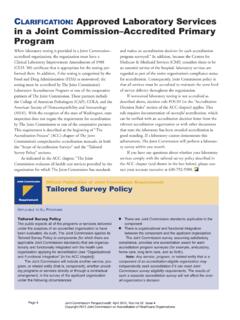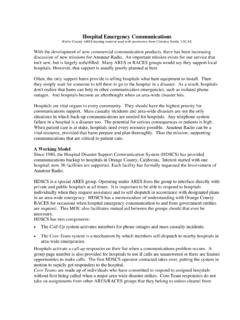Transcription of Standing Together: An Emergency Planning Guide for …
1 An Emergency Planning Guide for America s CommunitiesStanding TogetherStanding TogetherStanding TogetherAn Emergency Planning Guide for America s CommunitiesThe joint commission is proud to acknowledge its partnership with the following organizations in developing this Planning Guide :Illinois Department of Public HealthMaryland Institute of Emergency Medical Services SystemsNational Center for Disaster Preparedness at Columbia University Copyright 2005 by the joint commission on Accreditation of Healthcare rights reserved. No part of this book may be reproduced in any form or by any means without written permission from the of ContentsStanding together : An Emergency Planning Guide for America s CommunitiesExecutive Summary.
2 IvIntroduction .. 1 Emergency Management Leadership .. 4 Essential Components of the Planning Process .. 6 Section 1. Define the Community .. 7 Section 2. Identify and Establish the Emergency Management Preparedness and Response Team .. 9 Section 3. Determine the Risks and Hazards the Community Faces .. 15 Section 4. Set Goals for Preparedness and Response Planning .. 20 Section 5. Determine Current Capacities and Capabilities .. 31 Section 6. Develop the Integrated Plan .. 40 Section 7. Ensure Thorough Communication Planning .. 53 Section 8.
3 Ensure Thorough Mental Health Planning .. 62 Section 9. Ensure Thorough Planning Related to Vulnerable Populations .. 67 Section 10. Identify, Cultivate, and Sustain Funding Sources .. 70 Section , Exercise, and Drill Collaboratively .. 72 Section 12. Critique and Improve the Integrated Community Plan .. 80 Section 13. Sustain Collaboration, Communication, and Coordination .. 84 Closing Comment .. 89 Acknowledgment of Roundtable Members .. 90 Selected Resources .. 94 Index .. 97 Executive SummaryivDespite the passage of four full years sinceSeptember 11, 2001, many small communities inthe United States are struggling to meet the man-date for Emergency preparedness and responsethat would enable them to function on their ownin the hours or days before help arrives fromregional, state, and federal sources.
4 Readiness bar-riers include lack of clarity about who is respon-sible for preparedness and response Planning , whatelements of the Planning and response processesare critical, how to coordinate with state and fed-eral Emergency management programs, and howto obtain and sustain or what-ever disaster or mass casualty event occurs, com-munity and local response will be key to survival;communities must look to themselves and adjoin-ing communities for Planning Guide provides expert guidance onthe Emergency management Planning process thatis applicable to small, rural, and suburban commu-nities.
5 Its goal is to remove readiness barriers byproviding all communities with strategies, process-es, and tools for coordinated Emergency manage-ment Planning . The target audience is local lead-ers including elected or appointed officials,health care providers and practitioners, publichealth leaders, and others who are responsible forinitiating and coordinating the Emergency man-agement Planning effort in towns, suburbs, andrural areas throughout the United develop this Planning Guide , the JointCommission partnered with the IllinoisDepartment of Public Health, the MarylandInstitute of Emergency Medical Services Systems.
6 And the National Center for EmergencyPreparedness at Columbia University and con-vened two expert roundtable meetings in Mayand October of roundtables addressedthe issue of Emergency management Planning insmall, rural, and suburban communities; synthe-sized the challenges; and framed potential solu-tions. This document reflects the extensive inputreceived from roundtable no one Planning tool or template canprovide the breadth of guidance needed, this plan-ning Guide is offered as a multifunctional tool ortemplate.
7 It outlines 13 essential components of aneffective community-based Emergency manage-ment Planning process and provides multipleplanning strategies addressing each components include the following:1. Define the Identify and establish the Emergency manage-ment preparedness and response Determine the risks and hazards the communi-ty Set goals for preparedness and response Determine current capacities and Develop the integrated Ensure thorough communication Ensure thorough mental health Ensure thorough Planning related to Identify, cultivate, and sustain funding Train, exercise, and drill Critique and improve the integrated commu-nity Sustain collaboration, communication.
8 Of the 13 sections includes supporting toolsand provides links to Web sites that offer up-to-date Planning strategies are sum-marized at the beginning of each component sec-tion for ready reference. Thus, this Guide can beused in a modular fashion to address discrete areasof interest to particular Planning team it can be read cover to cover as a comprehen-sive Guide to community Emergency together : An Emergency Planning Guide for America s CommunitiesStanding together : An Emergency Planning Guide for America s CommunitiesThis Guide emphasizes two Planning strategiesthat are of particular significance to small, rural,and suburban communities.
9 The first is to enablepeople to care for themselves, and the second is tobuild on existing people to care for themselvesPlanning that prepares the community to helpitself can serve to reduce the potential surge indemand for services experienced during an actu-al Emergency . The Emergency plan needs toinclude a well-defined risk communication planthat contains information on the guidance thatwill be provided to the public and how that guid-ance will occur (for example, through distributionof fliers or other written material, or public ser-vice announcements on local radio and televisionstations).
10 Some types of emergencies can be man-aged in homes if proper information, such as howto prevent and treat influenza in low-risk individ-uals during an outbreak in the community, ismade available. For certain kinds of chemicalexposure, the instruction to stay at home and takea shower rather than go to the hospital to bedecontaminated is appropriate. Other types ofemergencies will require mass evacuation, whichis best supported by ongoing public communica-tion, education, testing, and drills. Hurricane plansin Florida provide an excellent example of proac-tive, multilingual, and pervasive preparedness;evacuation signs are well recognized throughoutcommunities in awareness, education, and engage-ment can be supported not only through formalpublic health and public safety mechanisms andthe local media, but also at a grass roots levelthrough a range of community groups, such ascivic organizations, religious groups, Boy/GirlScout troops, and high school sport teams, amongothers.
